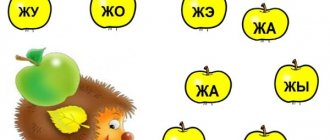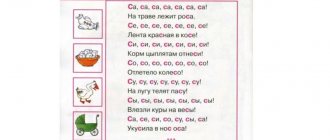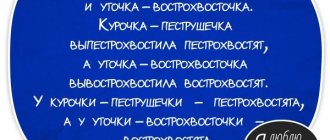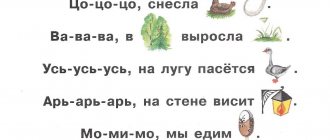Automation [L] in connected speech
Fixing a phoneme in coherent speech is the most important stage of automation. At this stage, work with the phoneme in specially organized situations is completed. Next, the phoneme will be used in your own spontaneous utterances.
Not all children need to practice pronunciation using text material - if a child easily uses the given sound without difficulty, it is advisable to start spontaneous speech. But most children definitely need reinforcement in the text. For work, short stories are chosen, enriched with the phoneme being practiced.
When working with texts, sound is used without lengthening, without exaggerated articulation. The phoneme must be equivalent in relation to the flow of other phonemes. At this stage, stories of different types are used:
- Stories based on reference pictures are a transitional step from repeating phrases to retelling texts. Stories should be short, [L] should be contained in only a few words, which are proposed to be inserted in the right place after showing the image.
- Stories-tasks. The work begins in a similar way with one or two words. The speech therapist reads the problem, the child must solve it and answer orally in one word, and then in an expanded phrase.
- Stories on leading questions.
- Ordinary stories with a lot of fixed phoneme. Questions are also allowed here.
- Writing a story on a specific topic. The child is given a topic for an essay and words with a fixed phoneme, which he must include in his story. These classes prepare you for incorporating phonemes into your own speech.
Automation [L] in poems
When a child learns to accurately pronounce sound in words, phrases and sentences rich in it, you can begin to reinforce it in poems.
For classes, it is advisable to select works that do not contain oppositional sounds [L] and [P] or those with which [L] was replaced before production.
You should try to choose poems with a meaning that is accessible to the child, based on his age characteristics and level of general development. If there are unknown or incomprehensible words, you need to carry out dictionary work, during which their meaning is explained. Understanding the meaning helps when speaking the text.
If a poem provokes the emergence of negative emotions or associations, you should not insist on working with it.
There is no need to offer long poems to a small child - it is difficult for a child to retain a large plot, he will lose the thread of meaning and reproduce a set of words. You cannot use poems with too long lines or a complex word order - this also complicates the understanding of the meaning and worsens the quality of speech.
The poem is offered one line at a time, and the child is asked to repeat. This process is called reflected recitation. Joint simultaneous pronunciation (conjugate) is not allowed at this stage. If a preschooler has difficulty remembering and reproducing the entire line at once - he cannot remember, confuses the order of words, or incorrectly says the sound being reinforced in one or more words - he needs to switch to repeating one word at a time. When introducing a child to a text, you should use your voice to highlight the phoneme being studied.
Words are pronounced in accordance with orthoepic rather than spelling rules. The same verse must be practiced over several lessons. Poems previously known to the child, but with a broken phoneme, are relearned after going through all stages of automation.
Automation [L] in a phrase
Automation of the sound [L] in sentences represents a transitional link between the artificial pronunciation of individual words and independent speech. The child needs to control the correctness of the pronounced sound, as well as convey the essence of the statement. In addition, to pronounce a phrase consisting of several words, a long, even exhalation is required.
To move on to pronouncing phrases, it is necessary to speak the phoneme quite freely, and not use syllable-by-syllable pronunciation. The speech organs must quickly adapt from one articulatory position to another. It is advisable to use pure tongue twisters and tongue twisters. It is extremely undesirable at this stage to incorrectly pronounce the sound being studied.
It is necessary to cultivate a calm, smooth pace of speech. If a child speaks quickly and pronounces sounds vaguely, he will not get used to controlling the correctness of his own speech. Such a child can deform or skip even those phonemes that he speaks correctly in isolation. Developing a measured speed provokes an improvement in sound pronunciation. Speech volume is also important.
Automation [L] in words
You should not fix the phoneme in syllables for too long; you should start working on words as quickly as possible. This is important because in words the sound is surrounded by other sounds that leave a characteristic auditory-speech imprint. Also, children perceive meaningful, meaningful words more easily.
In addition to the meaning accessible to the child, words for automation work play a very significant role. They help fix the phoneme in different positions and create the necessary articulatory patterns. The child does not memorize all the words of his native language with the studied phoneme, he learns to pronounce various combinations with the new phoneme, which will later be used in other words containing the phoneme [L].
Automation of [L] in words is carried out according to the following algorithm:
- Practicing words starting with [L].
- Practicing the intervocalic position [L] (between two vowels).
- Practicing words ending in [L].
- Practicing [L] in the middle of a word.
- Consolidation in words containing several sounds [L].











